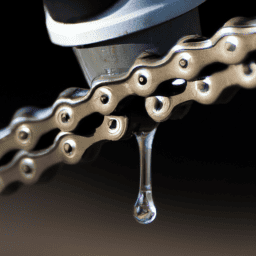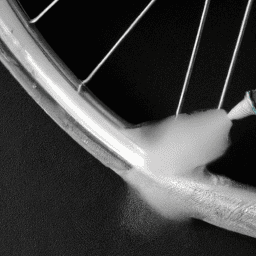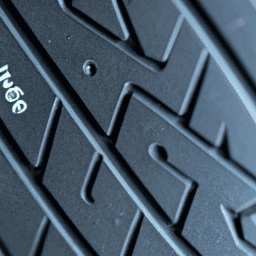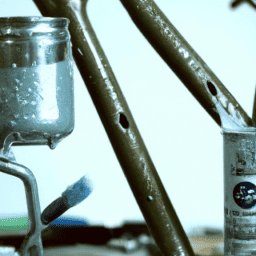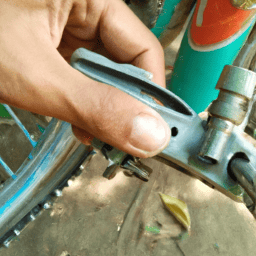While cycling on a gorgeous summer day, I unexpectedly began to hear a squeaking sound emanating from my chain. It almost seemed as though the bike was voicing its grievances over being neglected.
That’s when I realized it was time to oil my chain. Just like a car needs regular oil changes to keep running smoothly, a bicycle chain also requires proper maintenance to ensure it lasts longer and performs better.
In this article, I will guide you through the step-by-step process of how to oil a bicycle chain. From gathering your supplies to reassembling your bike, I will provide you with all the information you need to properly maintain your chain.
So, whether you’re an experienced cyclist or just getting started, get ready to learn how to keep your chain running smoothly and extend the life of your bicycle.
Key Takeaways
- Choosing the right lubricant is crucial for effective oiling.
- Cleaning the chain before oiling is important to remove dirt and debris.
- Applying the right amount of oil and distributing it evenly is essential for proper lubrication.
- Regularly cleaning and lubricating the chain is important to prevent corrosion and wear and tear.
Gather Your Supplies
Grab all the things you’ll need – a rag, lubricating oil, and some paper towels. Before you start oiling your bike chain, it’s important to choose the right lubricant. Not all lubricants work the same way and some may not be suitable for your bike. Check your bike’s manual or ask a professional to identify the right lubricant for your chain.
Once you have the right lubricant, you can move on to the next step. Cleaning your chain before oiling is also an important step. Use a clean rag to wipe off any dirt, debris, or old oil from the chain. Make sure to get into all the nooks and crannies of the chain, using a brush if necessary. This will ensure that the new oil can penetrate the chain more effectively and provide better protection.
Once your chain is clean, you can proceed to prepare your bike for oiling.
Prepare Your Bike
Before you start, make sure your ride is stationary and secure. It’s important to prepare your bike before you apply oil to the chain. This involves cleaning the chain and removing any dirt or debris to avoid potential damage. Cleanliness is crucial to ensure that the oil can penetrate the chain and provide proper lubrication.
To prepare your bike, you’ll need a few supplies. Refer to the table below for a list of necessary items and their functions.
| Supplies | Function |
|---|---|
| Clean rag or towel | To wipe off dirt and debris |
| Degreaser | To remove old oil and grease |
| Brush | To scrub the chain and reach tight spots |
| Safety goggles and gloves | To protect your eyes and hands |
Once you have gathered your supplies, start by wiping down the chain with a clean rag or towel to remove any dirt or debris. Then, apply the degreaser to the chain and use the brush to scrub the chain thoroughly. Remember to wear safety goggles and gloves to protect yourself from any potential harm. Once the chain is clean, you can move on to the next step of applying the oil.
Apply the Oil
To properly lubricate your bike’s chain, it’s essential to apply the right amount of oil and distribute it evenly. The proper technique for applying oil to your bike chain is to hold the bottle of oil close to the chain and drizzle it onto the chain as you turn the pedals backward.
Make sure to apply oil to every link in the chain, but be careful not to overdo it. Too much oil can attract dirt and debris, which can cause damage to your bike’s chain and gears.
The frequency with which you should oil your bike’s chain depends on how often you ride it and the conditions in which you ride. If you ride frequently or in wet or muddy conditions, you may need to oil your chain more often than if you ride infrequently or in dry conditions.
As a general rule of thumb, it’s a good idea to oil your bike’s chain every 100-200 miles or every two to three months. With proper oiling and maintenance, your bike’s chain will last longer and perform better.
Now, let’s move on to reassembling your bike.
Reassemble Your Bike
Now it’s time to put your bike back together, making sure all components are properly aligned and tightened.
Begin by reattaching the bicycle chain to the chainring and the rear derailleur. Make sure the chain is properly seated and passes through the derailleur jockey wheels.
Then, reattach the rear wheel to the bike frame by sliding it back into the dropouts. Tighten the quick release skewer securely, but not too tight that it damages the frame or the wheel.
Check the wheel alignment by spinning it and observing the gap between the tire and the chainstay. If the gap is uneven, adjust the axle position until it is centered.
Next, check the shifting and braking systems by testing them for functionality. Shift through all the gears, making sure each one engages smoothly and quickly. Also, test the brakes by squeezing the levers and making sure they stop the bike effectively.
If there are any issues with the shifting or braking, troubleshoot the problem before riding the bike.
Bike maintenance is important to ensure your bike runs smoothly and safely. The next section will cover how to maintain your chain to prolong its lifespan.
Maintain Your Chain
Make sure you take care of your chain to keep it running smoothly and extend its life, so you can enjoy your rides without any unnecessary interruptions. One of the most important things you can do to maintain your chain is to regularly clean and lubricate it. This will prevent corrosion and wear and tear from damaging your chain.
When it comes to chain cleaning, there are a few options. You can use a degreaser or a specialized chain cleaner. It’s important to choose a cleaner that is specifically designed for bike chains and to follow the instructions carefully.
Once you have cleaned your chain, you can move on to lubrication. There are many different types of lubricants available, including wet and dry options. Wet lubricants are best for wet or muddy conditions, while dry lubricants are better for dry conditions. Again, it’s important to choose a lubricant that is specifically designed for bike chains and to follow the instructions carefully.
By regularly cleaning and lubricating your bike chain, you can ensure that it stays in good condition and provides you with a smooth ride.
Frequently Asked Questions
How often should I oil my bicycle chain?
I oil my bicycle chain every 100-150 miles to ensure optimal performance. Benefits of regular chain maintenance include smoother shifting and increased durability. Signs of a chain in need of oiling include rust and squeaking.
Is it necessary to clean my chain before oiling it?
Yes, it is necessary to clean the chain before oiling it. Chain cleaning alternatives include using a degreaser or wiping it down with a rag. Chain lubricant options include wet or dry lubricants, depending on riding conditions.
Can I use any type of oil on my bicycle chain?
To ensure optimal chain performance, proper oil selection is crucial. Not all oils are suitable for bike chains. Look for bike-specific lubricants that reduce wear and tear, repel dirt, and resist water.
How much oil should I apply to my bicycle chain?
Applying too much oil can attract dirt and debris, leading to a dirty and noisy chain. Proper oiling techniques involve applying a small amount of oil to each link, wiping off excess, and allowing it to penetrate before wiping again.
How long should I wait before riding my bike after oiling the chain?
After oiling my bike chain, I wait at least 10-15 minutes before riding. This allows the oil to fully penetrate the chain links and ensures proper lubrication. Good chain maintenance leads to better bike performance.
Conclusion
So, there you have it – a step-by-step guide on how to oil your bicycle chain. It may seem like a tedious task, but it’s worth it in the long run to keep your bike running smoothly and prevent wear and tear on your chain.
Remember to gather your supplies, prepare your bike, apply the oil, and reassemble your bike.
Now, you may be thinking, "But wait, won’t oiling my chain attract dirt and grime?"While it’s true that oil can attract dirt, it’s important to understand that a properly lubricated chain will actually repel dirt and grime better than a dry chain.
The oil creates a barrier that prevents dirt and debris from sticking to the chain, and it also helps to prevent rust and corrosion. Of course, you’ll still need to clean your chain regularly to keep it in top condition.
But by oiling your chain regularly, you’ll be taking an important step towards keeping your bike in great shape and ensuring a smooth, enjoyable ride. So go ahead and give it a try – your bike (and your legs) will thank you!
